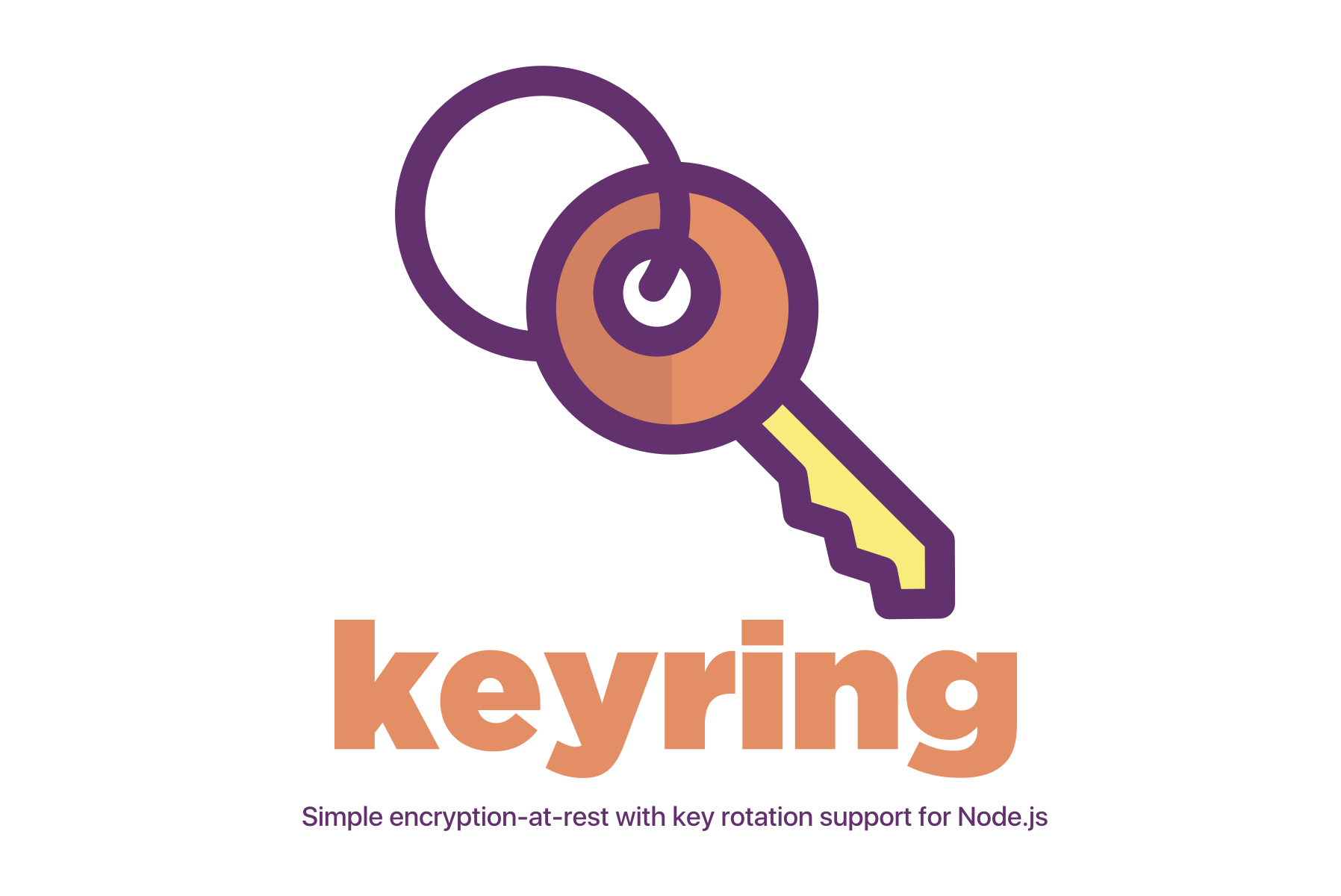keyring
Simple encryption-at-rest with key rotation support for Python.
N.B.: keyring is not for encrypting passwords--for that, you should use something like bcrypt. It's meant for encrypting sensitive data you will need to access in plain text (e.g. storing OAuth token from users). Passwords do not fall in that category.
This package is completely independent from any storage mechanisms; the goal is providing a few functions that could be easily integrated with any ORM.
Installation
Add package to your requirements.txt or:
pip install keyring
Usage
Encryption
By default, AES-128-CBC is the algorithm used for encryption. This algorithm uses 16 bytes keys, but you're required to use a key that's double the size because half of that keys will be used to generate the HMAC. The first 16 bytes will be used as the encryption key, and the last 16 bytes will be used to generate the HMAC.
Using random data base64-encoded is the recommended way. You can easily generate keys by using the following command:
$ dd if=/dev/urandom bs=32 count=1 2>/dev/null | openssl base64 -A
qUjOJFgZsZbTICsN0TMkKqUvSgObYxnkHDsazTqE5tM=
Include the result of this command in the value section of the key description in the keyring. Half this key is used for encryption, and half for the HMAC.
Key size
The key size depends on the algorithm being used. The key size should be double the size as half of it is used for HMAC computation.
aes-128-cbc: 16 bytes (encryption) + 16 bytes (HMAC).aes-192-cbc: 24 bytes (encryption) + 24 bytes (HMAC).aes-256-cbc: 32 bytes (encryption) + 32 bytes (HMAC).
About the encrypted message
Initialization vectors (IV) should be unpredictable and unique; ideally, they will be cryptographically random. They do not have to be secret: IVs are typically just added to ciphertext messages unencrypted. It may sound contradictory that something has to be unpredictable and unique, but does not have to be secret; it is important to remember that an attacker must not be able to predict ahead of time what a given IV will be.
With that in mind, keyring uses base64(hmac(unencrypted iv + encrypted message) + unencrypted iv + encrypted message) as the final message. If you're planning to migrate from other encryption mechanisms or read encrypted values from the database without using keyring, make sure you account for this. The HMAC is 32-bytes long and the IV is 16-bytes long.
Keyring
Keys are managed through a keyring--a short python Dictionary describing your encryption keys. The keyring must be a Dictionary object mapping numeric ids of the keys to the key values. A keyring must have at least one key. For example:
{
"1": "uDiMcWVNTuz//naQ88sOcN+E40CyBRGzGTT7OkoBS6M=",
"2": "VN8UXRVMNbIh9FWEFVde0q7GUA1SGOie1+FgAKlNYHc="
}
The id is used to track which key encrypted which piece of data; a key with a larger id is assumed to be newer. The value is the actual bytes of the encryption key.
Key Rotation
With keyring you can have multiple encryption keys at once and key rotation is fairly straightforward: if you add a key to the keyring with a higher id than any other key, that key will automatically be used for encryption when objects are either created or updated. Any keys that are no longer in use can be safely removed from the keyring.
It's extremely important that you save the keyring id returned by encrypt(); otherwise, you may not be able to decrypt values (you can always decrypt values if you still possess all encryption keys).
If you're using keyring to encrypt database columns, it's recommended to use a separated keyring for each table you're planning to encrypt: this allows an easier key rotation in case you need (e.g. key leaking).
N.B.: Keys are hardcoded on these examples, but you shouldn't do it on your code base. You can retrieve keyring from environment variables if you're deploying to Heroku and alike, or deploy a JSON file with your configuration management software (e.g. Ansible, Puppet, Chef, etc).
Basic usage of keyring
from keyring import Keyring;
keys = { '1': "uDiMcWVNTuz//naQ88sOcN+E40CyBRGzGTT7OkoBS6M=" }
encryptor = Keyring(keys, { "digest_salt": "salt-n-pepper" })
# STEP 1: Encrypt message using latest encryption key.
encrypted, keyringId, digest = encryptor.encrypt("super secret")
print(f'🔒 {encrypted}')
print(f'🔑 {keyringId}')
print(f'🔎 {digest}')
#=> 🔒 Vco48O95YC4jqj44MheY8zFO2NLMPp/KILiUGbKxHvAwLd2/AN+zUG650CJzogttqnF1cGMFb//Idg4+bXoRMQ==
#=> 🔑 1
#=> 🔎 c39ec9729dbacd45cecd5ea9a60b15b50b0cc857
# STEP 2: Decrypted message using encryption key defined by keyring id.
decrypted = encryptor.decrypt(encrypted, keyringId)
print(f'✉️ {decrypted}')
#=> ✉️ super secret
Change encryption algorithm
You can choose between AES-128-CBC, AES-192-CBC and AES-256-CBC. By default, AES-128-CBC will be used.
To specify the encryption algorithm, set the encryption option. The following example uses AES-256-CBC.
from keyring import Keyring
keys = { "1": "uDiMcWVNTuz//naQ88sOcN+E40CyBRGzGTT7OkoBS6M=" }
encryptor = Keyring(keys, {
"encryption": "aes-256-cbc",
"digest_salt": "
"
,
})
Exchange data with Ruby
If you use Ruby, you may be interested in https://github.com/fnando/attr_keyring, which is able to read and write messages using the same format.
Exchange data with Node.js
If you use Node.js, you may be interested in https://github.com/fnando/keyring-node, which is able to read and write messages using the same format.
Development
After checking out the repo, run pip install -r requirements.dev.txt to install dependencies. Then, run pytest to run the tests.
Contributing
Bug reports and pull requests are welcome on GitHub at https://github.com/dannluciano/keyring-python. This project is intended to be a safe, welcoming space for collaboration, and contributors are expected to adhere to the Contributor Covenant code of conduct.
License
The gem is available as open source under the terms of the MIT License.
Icon
Icon made by Icongeek26 from Flaticon is licensed by Creative Commons BY 3.0.
Code of Conduct
Everyone interacting in the keyring project’s codebases, issue trackers, chat rooms and mailing lists is expected to follow the code of conduct.
Acknowledgments
Inspired:
- by @fnando on keyring-node and attr_keyring
- and by Corona Virus
Thanks to IFPI for pay my salary!

